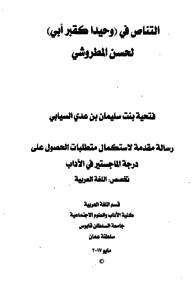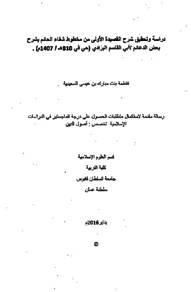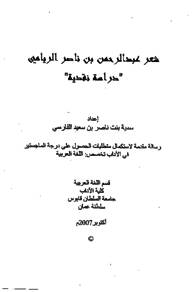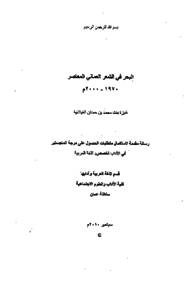Document
التناص في (وحيدا كقبر أبي) الحسن المطروشي.
Publisher
جامعة السلطان قابوس
Gregorian
2017
Language
Arabic
English abstract
In this study titled "Intertextuality" I seek to explore the concept of intertextuality in the poetic collection "Alone like My father's Grave" authored by the poet Hassan Al-Matroushi. The study approaches the concept from two perspectives – theoretical and practical debate and it contains as part of its apparatus an introduction, prologue and three chapters.
The prologue features the biography of the poet and his poetic achievements as well as the probing the concepts of text and intertextuality as depicted in language encyclopedias. In fact, intertextuality runs against the old patterns of literary criticism and it has effectively served as a point of departure between intertextuality and plagiarism and the concept has been abundantly and densely argued in both western and Arab literatures.
The study then follows intertextuality through its evolution and various manifestations besides discussing the sources from a critical standpoint as well as touching on intertextual production. This is mainly the theoretical part. However, the pragmatic methodology adopted in the research impelled me to devote three chapters to the practical argument. Chapter I defines and identifies the various resources of intertextuality and it is clearly demonstrable that religious intertextuality is the most common and frequently referenced and represented type of intertextuality in the collection and, therefore, merited the advantage to start with. Chapter II covers the historical intertextuality while Chapter III explores the mythic intertextuality, literary intertextuality and intertextuality driven by popular folklore.
It is quite obvious that intertextuality holds special place in the poetry of Hassan Al-Matroushi his texts are replete with references to another texts made in order to clarify his ideas and build up and demonstrate his vision. Intertextuality has become widely accepted and taken for granted it cannot be denied or ignored when investigating any literary text particular modern textual materials. Critics have to identify the points of creativity lurking in the deployed texts and assign their role in the modern text in order to showcase their aesthetics and creative features as intertextuality should not be understood as only about indicating the sources but also delving deeper into the immense panorama of the text and analyze it in order to capture the underlying creativity pursued by the poet to communicate his ideas.
Member of
Resource URL
Arabic abstract
تناولت في هذا البحث المعنون بالتناص في (وحيدا كقبر أبي الحسن المطروشي، مصطلح التناص في الديوان المذكور، وقد جاءت الدراسة جامعة بين الجانبين النظري والتطبيقي، قسمتها إلى مقدمة ومدخل وثلاثة فصول.
ورد في المدخل التعريف بالشاعر وإنجازاته ومفهوم النص ومفهوم التناص كما جاء في المعاجم اللغوية، والتناص ضد النقد القديم ومنه تم التفريق بين التناص والسرقات الأدبية، ثم الحديث عن نشأة التناص في النقدين الغربي والعربي، وتطرق بعدها إلى موضوع التناص ونقد المصادر وموضوع إنتاجية التناص. وهذا هو الجانب النظري في الدراسة، أما الجانب التطبيقي فقد اقتضت منهجية البحث تقسيمه إلى ثلاثة فصول. في الفصل الأول تم تحديد مصادر التاص بأنواعها في جدول ومن خلاله تبين أن التناص الديني أكثر أنواع النقاص ورودا في الديوان فسوغ البدأ به، أما الفصل الثاني فجاء فيه التناص التاريخي، والفصل الثالث كان عن النقاص الأسطوري والتناص الأدبي والتناص مع الموروث الشعبي.
ولقد ثبت من خلال الدراسة أهمية التناص في شعر حسن المطروشي، حيث لم يخل نص من نصوص الديوان من وجود إشارة لنص آخر، استثمرها الشاعر في توضيح فكرته وإبراز رؤيته، وقد أصبحت ظاهرة التناص ظاهرة مسلما بها، ولم يعد بالإمكان إنكارها أو تجاهلها، عند دراسة أي نص أدبي، ولا سيما النصوص الحديثة منها، وعلى الناقد أن يجد مكامن الابداع في النصوص الموظفة، ويبرز دورها في النص الحديث، حتى يستخرج مظاهر الابداع الجمالي فيها، فليس التناص هو استخراج المصدر وتحديده، وإنما لا بد من الغوص في ثنايا النص وتحليله، ومعرفة ما قدم فيه الشاعر من إبداع، من أجل ايصال فكرته.
ورد في المدخل التعريف بالشاعر وإنجازاته ومفهوم النص ومفهوم التناص كما جاء في المعاجم اللغوية، والتناص ضد النقد القديم ومنه تم التفريق بين التناص والسرقات الأدبية، ثم الحديث عن نشأة التناص في النقدين الغربي والعربي، وتطرق بعدها إلى موضوع التناص ونقد المصادر وموضوع إنتاجية التناص. وهذا هو الجانب النظري في الدراسة، أما الجانب التطبيقي فقد اقتضت منهجية البحث تقسيمه إلى ثلاثة فصول. في الفصل الأول تم تحديد مصادر التاص بأنواعها في جدول ومن خلاله تبين أن التناص الديني أكثر أنواع النقاص ورودا في الديوان فسوغ البدأ به، أما الفصل الثاني فجاء فيه التناص التاريخي، والفصل الثالث كان عن النقاص الأسطوري والتناص الأدبي والتناص مع الموروث الشعبي.
ولقد ثبت من خلال الدراسة أهمية التناص في شعر حسن المطروشي، حيث لم يخل نص من نصوص الديوان من وجود إشارة لنص آخر، استثمرها الشاعر في توضيح فكرته وإبراز رؤيته، وقد أصبحت ظاهرة التناص ظاهرة مسلما بها، ولم يعد بالإمكان إنكارها أو تجاهلها، عند دراسة أي نص أدبي، ولا سيما النصوص الحديثة منها، وعلى الناقد أن يجد مكامن الابداع في النصوص الموظفة، ويبرز دورها في النص الحديث، حتى يستخرج مظاهر الابداع الجمالي فيها، فليس التناص هو استخراج المصدر وتحديده، وإنما لا بد من الغوص في ثنايا النص وتحليله، ومعرفة ما قدم فيه الشاعر من إبداع، من أجل ايصال فكرته.
Category
Theses and Dissertations





